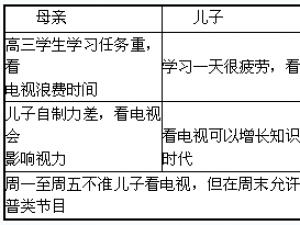第一部分教育理论与实践
Ⅰ.单项选择题(5分)
1. 《中华人民共和国教育法》自( )起开始实施。
A.1990年9月1日
B.1995年9月1日
C.1992年9月1日
D.1998年9月1日
2. 当某教师在课堂时,学生不声不响,而当离校或离开课堂以后,学生纪律立即松懈。与这种课堂纪律有关的教师领导类型最可能是( )。
A.专断型
B.民主型
C.放任型
D.无法确定
3. 思想品德教育最基本的方法是( )。
A.榜样法
B.说服法
C.评价法
D.陶冶法
4.教学原则反映了( )。
A.教育现象
B.教学规律
C.教学现象
D.师生关系
5. 苏霍姆林斯基的教育思想是( )。
A.和谐教育思想
B.教学过程最优化
C.教学发展观
D.全面发展观
Ⅱ.多项选择题(6分)
1. 加强和改进师德建设的总体要求是:以马克思列宁主义、——重要思想为指导,紧紧围绕全面实施素质教育、全面加强青少年思想道德建设和思想政治教育。( )
A.“八荣八耻”
B.毛泽东思想
C.邓小平理论
D.“三个代表”
2. 教师的劳动价值主要体现在教育劳动的( )。
A.个人价值
B.社会价值
C.主体价值
D.教育价值
3. 评价教师课堂教学质量的基本因素有( )。
A.教学目标明确
B.学生参与学习的积极性高
C.教育方法恰当
D.教学组织合理
Ⅲ.简答题(4分)
教师应具备哪些心理素质?
Ⅳ.简要分析题(15分)
启发式和注入式是两种对立的教学方法体系,试对两者作简要分析。
第二部分英语专业基础知识
Ⅰ.词汇与结构/Vocabulary and structure(15分)
从每题所给的A、B、C、D四个选项中,选出可以填入空白处的最佳选项。
1. A person who has _________ final say in an international company is usually influential one.
A. a; the
B. the; an
C. the; the
D. a; an
2. People _________ the new TV play.
A. think high of
B. think well of
C. think poor of
D. think good of
3. The company hopes to sell _________ these machines.
A. millions
B. million
C. millions of
D. million of
4. It was an exiting moment for these football fans this year, _________ for the first time in years their team won the World Cup.
A. that
B. while
C. which
D. when
5. Paul attends, very _________ meetings, and when he does, he has very to say.
A. little ; few
B. few ; little
C. a little; a few
D. a few; a little
6. The subject _________ we are going to turn is about English studies.
A. about which
B. with which
C. about that
D. to which
7. Everyone except Tom and John _________ there when the class began.
A. are
B. is
C. were
D. was
8. "Isn' t the TV play wonderful? " This sentence means _________.
A. What a wonderful play it is!
B. Do you think the TV play wonderful?
C. I don' t think the TV play is wonderful.
D. Do you know what the play is like?
9. --Who told you about Follow Me?
-- _________. I picked it up _________.
A. No one; my own
B. No one; myself
C. None ; by myself
D. None ; myself
10.--This digital camera is really cheap!
--The _________ the better. I'm short of money, you see.
A. cheap
B. cheaper
C. expensive
D. more expensive
11. The prisoner of war wished to be _________ Ten years later, he _________ free and regained his _________.
A. free ; was set ; free
B. freely; was set; freedom
C. free; set ; freedom
D. free ; was set; freedom
12. Family education has a great _________ on children in many ways.
A. result
B. danger
C. disadvantage
D. effect
13. Don't all speak at once! _________ , please.
A. Each at one time
B. one by one time
C. one for each time
D. One at a time
14. --This dress was last year's style.
--I think it still looks perfect _________ it has gone out this year.
A. so that
B. even though
C. as if
D. ever since
15. Don't forget the day _________ you were received into the Youth League.
A. when
B. that
C. at which
D. where
Ⅱ.完形填空/Close(30分)
